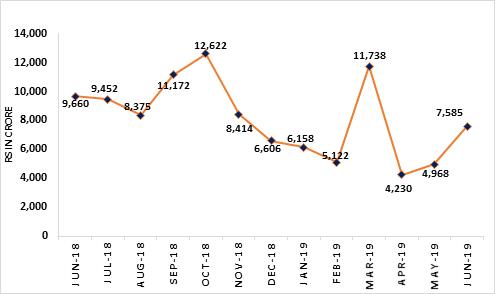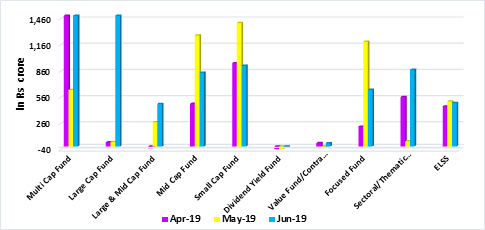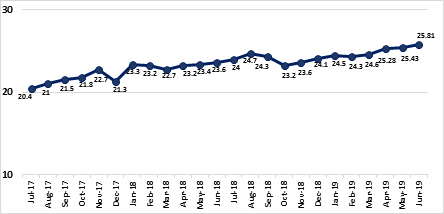 (Image source: Image by Jonathan Rolande from Pixabay)
(Image source: Image by Jonathan Rolande from Pixabay)
The recent monthly figures released by the Association of Mutual Funds of India (AMFI) suggest that equity inflows have risen steeply by 53% over a month (as seen from the graph). Post the drop in equity inflows for the month of April, this increase in number for the month of June is very encouraging for the mutual fund industry. It also points out that equity mutual fund investment hasn't lost its momentum.
Graph 1: Equity inflow (Rs in Crore)

Data as of June 30, 2019
(Source: www.amfiindia.com)
Besides, the number of open-ended equity folios have risen to 58.8 million (5.8 crores) in June 2019 from 57.9 million (5.7crore) in April 2019, to push the overall count of a number of folios to 83.7 million (8.37 crore).
Table 1:Monthly rise in No of folios
| Month |
No of folios |
| Mar-19 |
8.25 |
| Apr-19 |
8.27 |
| May-19 |
8.32 |
| Jun-19 |
8.37 |
Data as of June 30, 2019
(Source: www.amfiindia.com)
And within the equity sub-category, multi-cap funds, large-cap funds, and thematic fund saw a heavy inflow of Rs 1,835 crore, Rs 1,510 crore, and Rs 879.80 crore respectively compared to the previous two months (as seen in the graph below).
Large-cap funds comprise of stocks of those companies that feature on the large cap's list as per market capitalisation. They are established names and the biggest advantage of having them is the stability they can provide to the portfolio.
Graph 2:Equity inflow/outflow of open-ended equity funds for consecutive three months

Data as of June 30, 2019
(Source: www.amfiindia.com)
The probable reasons for this kind of boost in equity inflows are:
-
Stable political environment
When the election results were out, speculation stopped. This provided some relief to retail investors. The NDA government's win with astounding numbers, for continued governance of Mr Modi for his second term as the PM, offered political stability and boosted the investors' confidence.
Investors bought exuding confidence in Modi 2.0, hoping the northward journey of the Indian equity markets will continue.
-
Lower inflation numbers
Besides, at the bi-monthly monetary policy review meeting held in June, headed by Mr Shaktikanta Das, the RBI reduced the repo rate by 25 basis points. This was done to achieve the medium-term target for consumer price index (CPI) inflation of 4 per cent inflation and to boost the subdued GDP.
[Read: Why A Slowdown in GDP Matters To You As An Investor?]
Plus, the Monetary Policy Committee (MPC) even changed the stance of monetary policy from neutral to accommodative. This move to control the rapid inflation, on the contrary, has encouraged the investors to choose equity funds for its ability to provide better inflation-adjusted returns over a long period of time.
-
Ripple effect continued in debt investment due to downgrading
In the recent past, the mutual fund houses have been financing distressed companies, without demanding adequate securities, and perhaps without undertaking a strict credit analysis.
Although the credit ratings should have been considered as a mere suggestive additional tool by fund managers while analysing the funds. The fund managers had relied too much on the independent credit rating agencies and they failed to update investors about the deteriorating conditions in the bond market.
So for the welfare of investors, the market regulator proposed stricter norms for liquid and debt funds. Earlier, there wasn't a limit set on holding debt instruments issued by corporates of any specific sector. Hence in order to generate better returns, the fund managers would take credit risk by exposing the portfolio to these downgraded companies.
Basically, the funds had exposure to a larger portion of 'AA' or lower rated papers. Below 'AA' rated papers indicate low quality, a lesser capacity to pay interest, and repay the principal as compared to 'AAA' ratings by the credit rating agencies.
The contagion effect of corporates downgrading due to defaults shook the faith investors had and pushed them away because they realised debt investment isn't risk-free.
Hence, the month of June saw a heavy outflow of Rs 1,71,349.32 crore in debt funds and this affected the Average Asset under Management as well. AAUM for the month of June touched Rs 25,81,397.21crore, to grow by 2% over the previous month.
Graph 3: Average AUM of the Indian Mutual Fund Industry (Rs in Trillion)

Data as of June 30, 2019
(Source: www.amfiindia.com)
But considering many headwinds were at play on macro and micro levels, such as geopolitical tensions, election outcome, RBI policy review and regulatory reforms, there was volatility in the debt and equity markets.
Surprisingly however, investors decided to ride this wave of troubled waters to their advantage vide rupee-cost averaging by investing in mutual funds via systematic investment plans.
This was projected by the numbers AMFI shared on the contribution to systematic investment plans (SIP) which stood at Rs 8,122.13 crore in June, coming in from 2.73 crore SIP accounts against Rs 8,183 crore in May.
In conclusion, PersonalFN is of the view that the Mutual Fund industry is witnessing investors breaking away from their old investment habits and choosing Mutual funds. They are getting smarter and wiser in terms of the investment decisions for their long-term benefit.
Editor's note: Looking for researched-backed advice and ready-made mutual fund portfolios?
Try out PersonalFN's specialized services: FundSelect Plus.
FundSelect Plus is the ANSWER to the fast, crazy world of mutual fund investing. If you are an investor who "likes to have everything ready beforehand", WITHOUT any effort on your part whatsoever, FundSelect Plus is probably for you.
Get instant access to 7 Readymade Portfolios, Tested & with Proven Strategies.
And there's some good news for you. We have rolled out a special offer only for serious investors. Click here to know more.

Add Comments